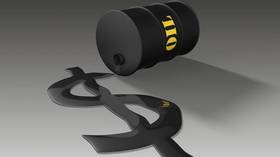Oil investments are drying up as crude demand falters

The COVID-19-induced shortage in key oil investments could spell trouble for the entire industry for years to come.
Thirty-five percent: this is the size of the spending cuts oil and gas companies are likely to have made this year in response to the effects that the coronavirus pandemic is having on demand, according to the International Energy Agency. And this is just the spending slump in upstream oil and gas. This is just part of a wider trend of investment cuts in the energy industry, according to the IEA, which earlier this month published an update of its World Energy Investment report, first released in late spring. At the time, some thought we were seeing the worst of the pandemic. They were, apparently, wrong.
Also on rt.com Oil prices hit 4-month low over fear new coronavirus lockdowns will crush demandDemand for oil has certainly improved in some parts of the world, notably in Asia, where governments have been more successful in containing the spread of the coronavirus than their counterparts in Europe and North and South America. But even in China – the world’s oil demand recovery driver –the rebound is slowing down. After all, even though its domestic demand may be improving, if regional and global demand is stalling, this will have a negative effect on China as well.
According to the IEA, the impact that the pandemic is having on investments in the oil industry will continue to be felt for years to come. This is hardly surprising: the agency noted a 45-percent cut in investments by US shale oil companies this year, combined with a 50-percent jump in financing costs. The number of active drilling rigs in the US may be rising, suggesting the beginning of a recovery, but the total was still down 564 rigs on the year as of last week, so that recovery will take a while.
Meanwhile, fuel stock updates from the Energy Information Administration are offering mixed signals: last week, for instance, saw a major drawdown in distillate fuel stocks, which should be good news suggesting demand for distillates is improving. The problem is that it is likely that this improvement is a temporary occurrence rather than a trend. Air travel is still greatly constrained, and the chances of any change in the status quo are slim.
Uncertainty: this is the keyword for not just the oil industry but for all others affected by the pandemic to such a grave extent as to force changes in business models. Europe’s Big Oil majors are doing just that with their push into renewables and plan to greatly reduce the contribution of their core business to overall earnings. USmajors are sticking with oil, and they may well have a good reason to do it.
There has been a lot of government and activist talk about a green recovery from the pandemic crisis. But the pandemic is still raging, and not only is it not abating, but it is gathering strength. This would mean more money needed for stimulus measures. This, in turn, would mean less money to spend on renewables, because despite the celebrated cost declines in solar and wind, financial and regulatory support from governments remains essential for their increased deployment.
Also on rt.com Central Bank of Russia does not rule out another pandemic wave & $25 oil priceThe future remains marred in uncertainty that extends to the possibility of a rebound in oil investments. According to some, such as BP, we are already past peak oil demand, so that would mean less investment in oil production growth globally. Others, such as OPEC producers, hope things will sooner or later return to normal, and the world’s appetite for more oil will continue to grow for at least a few more years before plateauing. And yet even OPEC is preparing for a worst-case scenario.
The extended cartel OPEC+ is considering a delay in the next relaxation of oil production cuts, from January 2021 to April, in response to the latest trends in Covid-19 infections. One thing seems relatively clear, however. The longer the surge in new infections continues, the longer it would take the industry to return on the path of recovery and growth.
This article was originally published on Oilprice.com














